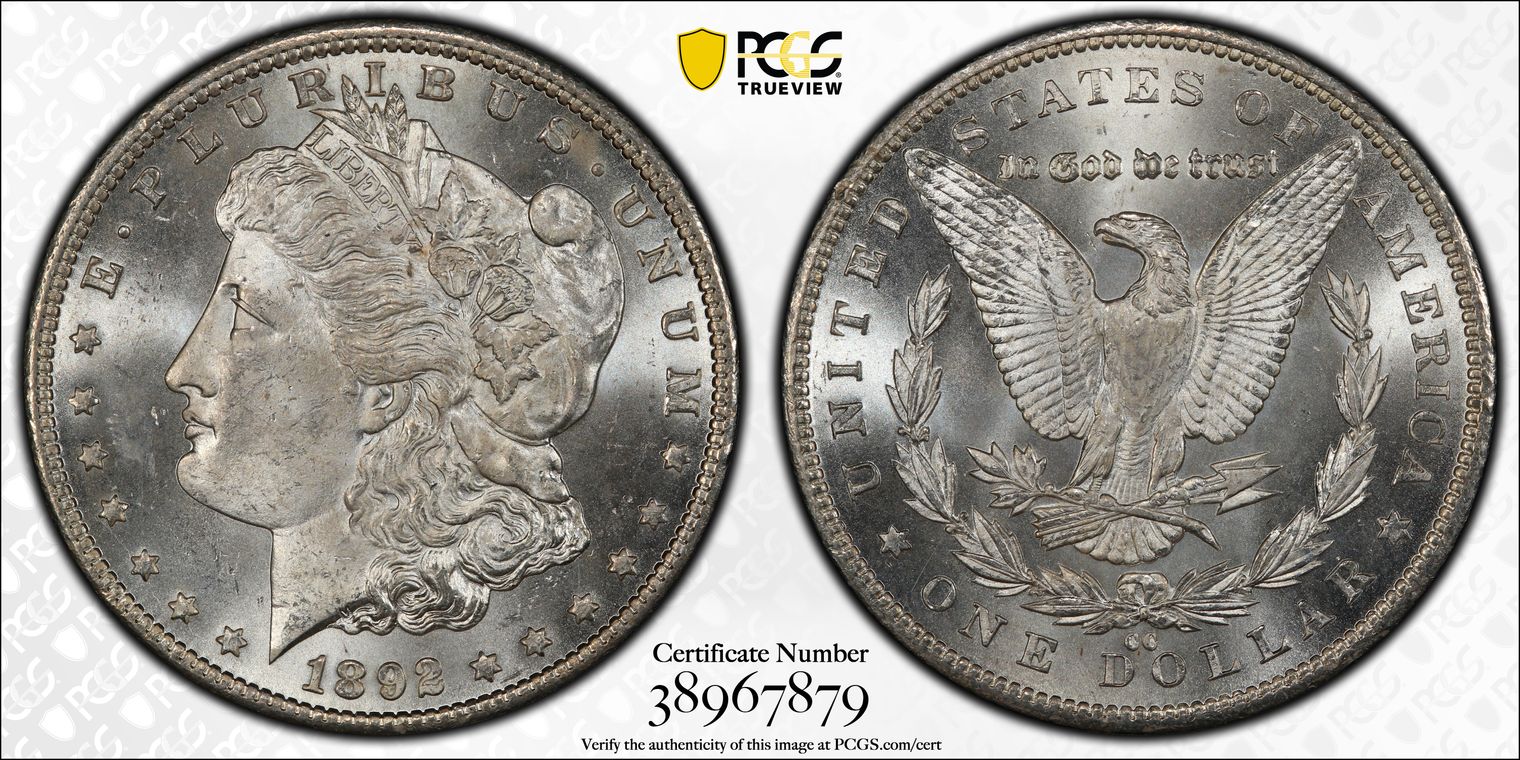1892-CC $1 MS65 认证号38967879, PCGS号7214
专家评论
Q. David Bowers
The following narrative, with minor editing, is from my "Silver Dollars & Trade Dollars of the United States: A Complete Encyclopedia" (Wolfeboro, NH: Bowers and Merena Galleries, Inc., 1993)Into circulation: Hundreds of thousands of 1892-CC dollars were put into circulation in the late nineteenth century.
Numismatic Information
Hoard coins: When the Carson City Mint closed down, quantities of 1892-CC dollars were shipped for storage to the San Francisco Mint and, to a lesser extent, to the Treasury Building in Washington, D.C. From the San Francisco Mint, quantities were paid out over a period of years, including 1925-1926, but particularly in the late 1940s and early 1950s. Some bags, but probably not many, were dispersed from the Cash Room at the Treasury Department in Washington during the same time frame, up through 1950-1953. Then came a quantity dispersal. Dealer Steve Ruddel stated that about 50 bags (50,000 coins) of 1892-CC dollars were released from the Treasury Building in 1955 alone. (Reference: His advertisement in The Numismatist, January 1964.)
Few if any 1892-CCs were part of the Treasury release of 1962-1964. When the government took stock of the situation in March 1964 and stopped paying out Morgan and Peace dollars of any and all dates, just a single Uncirculated 1992-CC dollar remained! The news of the non-availability of the 1892-CC in the surviving Treasury cache caused a run-up in prices in the 1960s and 1970s. However, Wayne Miller in his Morgan and Peace Dollar Textbook, 1982, reported that as of that time, "large quantities of this date still exist in BU condition."
Historically, the 1892-CC, like the 1990-CC and 1891-CC before it, was never considered to be a rare date. Enough were dispersed at or near the time of mintage that examples have been readily available on the market. However, in comparison to some of the 1878-1885 Carson City dollars sold by the G.S.A. in the 1970s, the 1892-CC is relatively elusive today.
Mint State grades: Most Mint State 1892-CC dollars are in lower grades and have many bagmarks. As Carson City Morgan dollars go, the 1892-CC is scarce today. Although the mintage of the 1892-CC exceeded that of 1882-CC, 1883-CC, and 1884-CC, it is much more elusive in Uncirculated grade, due to the relatively small amount of hoard coins remaining. Rolls or larger quantities are seldom seen on today's market. Higher Mint State level coins are scarce. Considering the great demand for them, MS-65 coins are an attraction whenever they are offered at auction or private sale. Most 1892-CC dollars are well struck with excellent frosty lustre.
Specific estimates are as follows: MS-60 to 62, 20,000 to 35,000 survive; MS-63, 8,000 to 15,000; MS-64, 3,000 to 5,000; and MS-65 or better, only 1,000 to 1,800.
Prooflike coins: A small percentage of Mint State coins are prooflike, and fewer yet are DMPL. Of the 155 DMPL coins certified by NGC and PCGS as of September 1992, none was above MS-64. Semi-prooflike coins are sometimes certified and/or sold as prooflikes. In the St. Louis Stamp & Coin sale of the George W. Rice Collection (1906), a "Brilliant Proof' brought a very high $7.10. Another, with a "tiny nick," brought $35 in Mehl's Atwater sale (1946); a third, "perfect," realized a remarkable $48.50 in his C.W. Green sale (1949). On the other hand, those offered by B.M. Douglas and William & L. Pukall (The Numismatist, 12/51, 10/53) were probably DMPLs. An uncertified coin shown to the author by Brian Hendelson in 1993 is virtually the equivalent of a Philadelphia Mint Proof and is the finest seen.
Circulated grades: In worn grades the 1892-CC is scarce but not rare.
Varieties
Circulation strikes:
1. Normal date: Breen-5629. Mintmarks are more irregularly placed than on previous CC coins, sometimes leaning left (was the Philadelphia Engraving Department's puncher left-handed?). One of the dies with second C low shows an attempt to correct the condition, second C repunched higher: VAM-4. The mintage may not have taken all 10 pairs of dies.
Dies prepared: Obverse: 10; Reverse: 10.
Circulation strike mintage: 1,352,000; Delivery figures by month: January: 106,000; February: 110,000; March: 110,000; April: 110,000; May: 110,000; June: 116,000; July: 110,000; August: 40,000; September: 126,000; October: 120,000; November: 140,000; December: 154,000.
Specimens sent to the Assay Commission: 676 Estimated quantity melted: Probably hundreds of thousands under the 1918 Pittman Act.
Availability of prooflike coins: 1892-CC dollars with prooflike surfaces are scarce, and DMPL coins are scarcer. Exceedingly rare MS-65 DMPL or finer. Most have deep mirror surfaces and if not extensively bagmarked are very attractive.
Characteristics of striking: Most are well struck, but some are flat at the centers.
Known hoards of Mint State coins: Scattered bags were released from storage in the San Francisco Mint in the late 1940s and early 1950s. The Redfield hoard (1976) is said to have had a bag or more of 1892-CC, but most coins were damaged by a counting machine.
Commentary
Most Mint State 1892-CC dollars are heavily bagmarked and exist in lower grade levels from MS-60 to 62.
PCGS #
7214
设计师
George T. Morgan
边缘
Reeded
直径
38.10 毫米
重量
26.73 克
铸币数量
1352000
金属成分
90% Silver, 10% Copper
更高评级数量
104
评级较低的钱币数量
12398
地区
The United States of America
价格指南
PCGS 数量报告
拍卖 - PCGS 评级的
拍卖 - NGC 评级的
稀有性和存量估计 了解更多
| 所有评级 | 135000 |
| 60或以上 | 55000 |
| 65或以上 | 1200 |
| 所有评级 | R-1.9 |
| 60或以上 | R-2.4 |
| 65或以上 | R-4.9 |
| 所有评级 | 33 / 117 TIE |
| 60或以上 | 52 / 117 TIE |
| 65或以上 | 45 / 117 TIE |
| 所有评级 | 33 / 117 TIE |
| 60或以上 | 52 / 117 TIE |
| 65或以上 | 45 / 117 TIE |





















